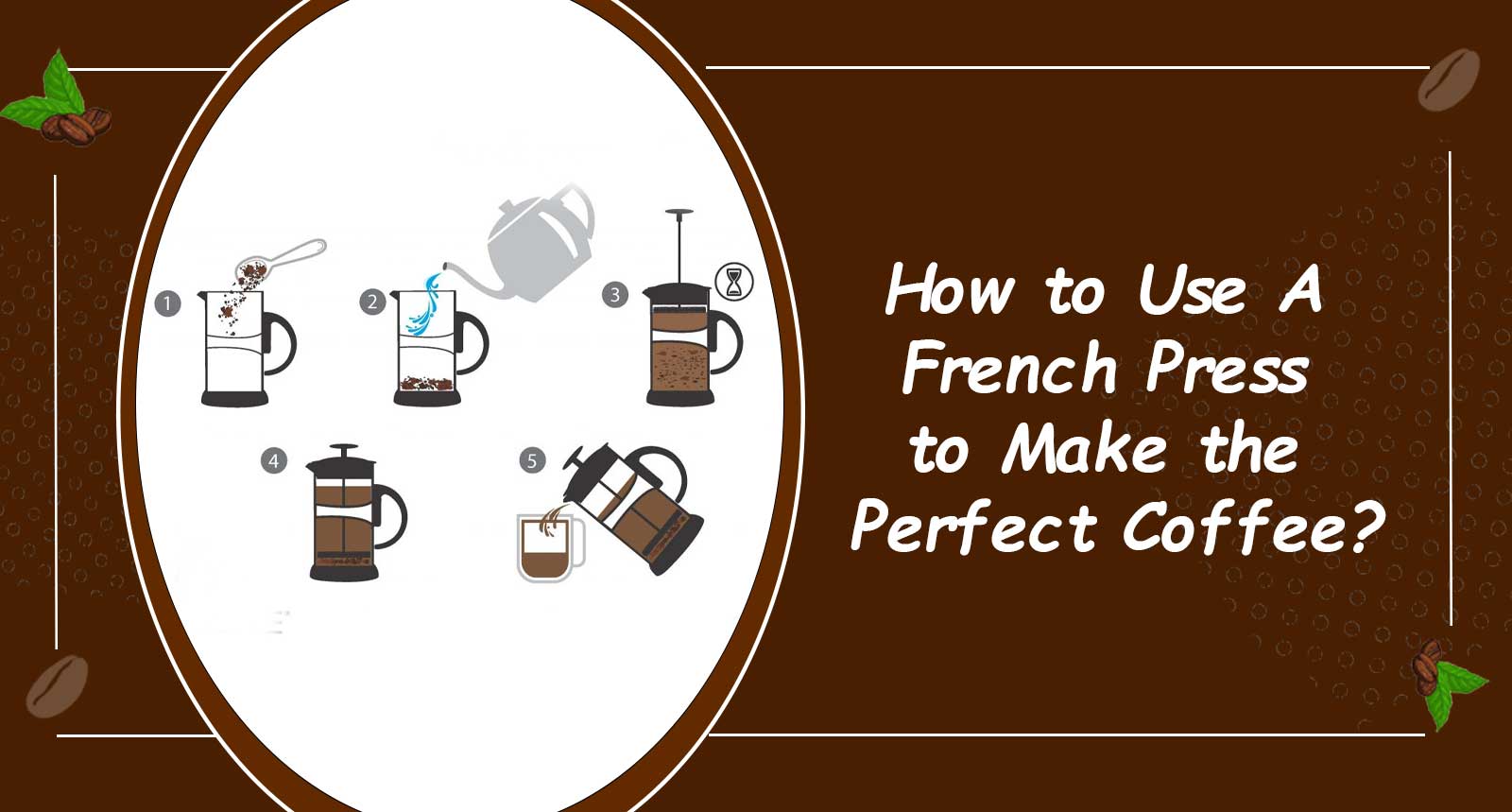I’m a coffee aficionado, and I know that the key to a great cup of coffee is all in the brewing method. If you’re like me and crave that perfect cup, you’re in for a treat.
We’ll delve into the art of using a French press to brew the perfect coffee. How to Use A French Press to Make the Perfect Coffee? It’s a question that many of us have pondered.
Brewing with a French press is an elegant and timeless method that allows you to savor the rich, full-bodied flavors of your favorite coffee beans.
Join me as we explore the step-by-step process to craft a cup of java that’s nothing short of perfection. Your journey to the perfect coffee starts here!
How a French Press Works to Make the Perfect Coffee?
To master the art of making the perfect coffee with a French press, it’s essential to understand how this simple yet effective brewing method works.
A French press, also known as a press pot or plunger pot, is a classic and versatile coffee maker that consists of a cylindrical glass or stainless steel container, a plunger with a metal or nylon mesh filter, and a lid. Here’s a detailed breakdown of how a French press works its magic:
Coffee Grounds
Start with your favorite coffee beans and grind them to a coarse consistency, similar to breadcrumbs. The coarser grind allows for better extraction and prevents over-extraction, resulting in a smoother, less bitter taste.
Hot Water
Heat water to just below boiling, ideally around 200°F (93°C). The temperature is crucial as it influences the extraction process. Hot water ensures that the coffee grounds release their full flavor.
Coffee and Water Ratio
Measure your coffee grounds and hot water carefully. A general rule of thumb is 1 ounce (28 grams) of coffee to 16 ounces (475 milliliters) of water, but you can adjust this to suit your taste preferences.
Adding Coffee
Place the coarsely ground coffee at the bottom of the French press. Ensure that the coffee bed is level to promote even extraction.
Blooming
Pour a small amount of hot water over the coffee grounds to saturate them evenly. This is called the “bloom.” Allow it to sit for about 30 seconds, during which time the coffee will release carbon dioxide gas and expand, resulting in a better extraction.
Pouring the Rest of the Water
After the bloom, slowly pour the rest of the hot water over the coffee grounds in a gentle, circular motion, ensuring even saturation.
Stirring
Use a long spoon or paddle to gently stir the coffee-water mixture to promote even extraction. Be cautious not to damage the filter.
Placing the Lid
Put the lid on the French press with the plunger pulled all the way up, trapping heat and aroma inside.
Brewing Time
Allow the coffee to steep for about 4 minutes. The steeping time can vary depending on your taste preferences, but a 4-minute brew is an excellent starting point.
Pressing Down the Plunger
After the brewing time is up, slowly press down the plunger with steady pressure. The metal or nylon mesh filter separates the coffee grounds from the liquid, leaving you with a smooth and flavorful coffee.
Pour and Enjoy
With the plunger down, your coffee is ready to be poured into your favorite mug. It’s now time to savor the perfect cup of coffee you’ve crafted.
French press is the first step towards brewing the perfect coffee. The simplicity of this method allows you to fine-tune each element, from coffee bean selection to water temperature and steeping time, to achieve a cup of coffee that suits your taste preferences perfectly.
What is a French Press?
A French press, often referred to as a press pot or plunger pot, is a popular and timeless manual coffee brewing device.
It consists of a few essential components: a cylindrical glass or stainless steel container, a plunger with a metal or nylon mesh filter, and a lid.
The French press is known for its simplicity, yet it produces a rich and flavorful cup of coffee. Here’s a closer look at each part of a French press:
Container
The container is typically made of glass, but you can also find models with stainless steel or plastic construction. It’s designed to hold your coffee grounds and hot water.
Plunger
The plunger is a long handle attached to a metal or nylon mesh filter. It is used to separate the coffee grounds from the liquid once the brewing process is complete. The plunger can be easily pressed down to filter out the grounds.
Lid
The lid fits snugly on top of the container and helps retain heat and aroma during the brewing process. Some lids also have a spout for easy pouring.
The French press operates on a straightforward principle: coffee grounds are steeped in hot water, and then the plunger is used to separate the grounds from the brewed coffee.
What sets the French press apart from other brewing methods is the ability to control various factors, such as grind size, water temperature, steeping time, and coffee-to-water ratio, to create a cup of coffee that caters to your personal taste preferences.
It’s a versatile and customizable way to make the perfect coffee right at home.
What is the Best Ratio of Coffee to Water for a French Press?
Achieving the perfect coffee with a French press relies on getting the coffee-to-water ratio just right. The ideal ratio can vary based on personal taste, the coarseness of your coffee grounds, and the size of your French press, but a commonly recommended ratio is 1 ounce (28 grams) of coffee to 16 ounces (475 milliliters) of water. This ratio provides a good starting point for a balanced and flavorful brew.
However, you have the flexibility to adjust this ratio to suit your preferences. Here are some key considerations for finding the best coffee-to-water ratio for your French press:
Strength Preference
If you prefer a stronger cup of coffee, you can increase the amount of coffee grounds relative to the water. Conversely, if you like a milder brew, use fewer coffee grounds.
Coffee Grind Size
The coarseness of your coffee grounds also plays a role. Coarser grounds require a slightly higher coffee-to-water ratio to extract the desired flavors.
French Press Size
Smaller French presses may require a higher coffee-to-water ratio to maintain the right intensity of flavor. Conversely, larger presses may need a slightly lower ratio.
Experimentation
The best way to find your ideal ratio is through experimentation. Start with the 1:16 ratio and adjust it with each brew until you achieve the taste you desire.
Achieving the perfect coffee is a matter of personal preference. The recommended ratio serves as a useful guideline, but don’t hesitate to fine-tune it to create a cup of coffee that suits your unique taste buds.
How Many Scoops of Coffee Should You Put in a French Press?
The number of coffee scoops you should use in a French press depends on several factors, including the size of your French press, your personal taste preferences, and the size of your coffee scoop.
As a general guideline, a common recommendation is to use one scoop of coffee for every six ounces (177 milliliters) of water. Here’s how you can determine the number of scoops for your French press:
French Press Size
Start by identifying the size of your French press. Most French presses are available in various capacities, such as 12 ounces (350 milliliters), 32 ounces (950 milliliters), or even larger.
Water Volume
Calculate the amount of water you plan to use. Typically, one cup of coffee is made using approximately 6 ounces (177 milliliters) of water.
Coffee-to-Water Ratio
Use the 1:6 coffee-to-water ratio as a baseline. For every 6 ounces of water, you would use one scoop of coffee. Adjust this ratio to match the size of your French press and your taste preferences.
Scoop Size
Keep in mind that coffee scoops come in various sizes. Some may hold more or less coffee than others. If you have a specific scoop, check its volume and adjust accordingly.
Experimentation
As with the coffee-to-water ratio, finding the right number of scoops is often a matter of experimentation. Start with the recommended ratio and adjust it based on the strength and flavor you desire.
The ideal number of scoops can vary from person to person. Some individuals prefer a stronger brew, while others enjoy a milder taste.
Use these guidelines as a starting point and fine-tune the number of scoops to craft a cup of coffee that perfectly suits your palate.
The beauty of a French press lies in its flexibility, allowing you to customize your coffee to your liking.
FAQs (Frequently asked question)
What is the ideal coffee-to-water ratio for a French press?
The recommended coffee-to-water ratio for a French press is typically 1 ounce (28 grams) of coffee to 16 ounces (475 milliliters) of water. However, this ratio can be adjusted to match your taste preferences and the size of your French press.
How do I choose the right grind size for French press coffee?
For a French press, it’s essential to use a coarse grind similar to breadcrumbs. Coarse grounds prevent over-extraction and ensure a smooth, flavorful brew. Experiment with grind size to find the one that works best for your taste.
What’s the ideal water temperature for brewing with a French press?
The ideal water temperature is around 200°F (93°C). Hot water at this temperature helps extract the coffee’s full flavor. Boil the water and allow it to cool slightly before pouring it over the coffee grounds.
How long should I steep the coffee in a French press?
A typical steeping time is about 4 minutes. However, the steeping time can be adjusted to achieve your preferred strength and flavor. Experiment with shorter or longer steeping times to find the sweet spot.
Can I use any type of coffee bean with a French press?
Yes, you can use any type of coffee bean with a French press. It’s a versatile method that works well with a variety of coffee beans, including single-origin, blends, and flavored coffees. Choose beans that align with your taste preferences for the perfect cup.

